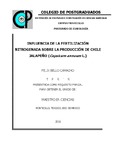| dc.description.abstract | El uso excesivo de nitrógeno en el cultivo de chile jalapeño no mejora el rendimiento, pero si incrementa innecesariamente los costos de producción, así como el riesgo de inducir efectos negativos al ambiente, por lo cual es necesario racionalizar su aplicación para optimizar la rentabilidad del sistema agrícola. Por ello, el objetivo de esta investigación fue evaluar la respuesta del chile jalapeño a diferentes niveles de nitrógeno sobre la fenología del cultivo, rendimiento y tamaño de fruto en madurez comercial. El experimento se llevó a cabo de julio del 2015 a enero del 2016 en condiciones de invernadero en las instalaciones del Laboratorio de Ingeniería de Riego del Campo Experimental Tlapeaxco de la Universidad Autónoma Chapingo. Se ensayaron cinco dosis de nitrógeno (0, 100, 200, 300 y 400 kg ha-1) en tres híbridos (USAPR 15338, Cheetah y Pitón) con diferente ciclo (60-65, 65-70 y 70-75 días a cosecha, respectivamente), estos se trasplantaron en sustrato de roca basáltica (tezontle). Se evaluó el calendario fenológico, características agronómicas y tamaño del fruto en madurez comercial. El N aplicado modificó el desarrollo del cultivo ya que para el tercer corte, con dosis de 100 kg de N ha-1 la madurez se adelantó en 49, 19 y 13 días en los híbridos USAPR 15338, Cheetah y Pitón, respectivamente, en comparación con dosis de N de 400 kg ha-1. El rendimiento de fruto al final del ciclo fue significativamente diferente entre tratamientos (p>F=<0.0001), ya que con dosis de 100 kg de N ha-1 se obtuvo 544 g planta-1 más que al aplicar 200 kg de N ha-1 para el híbrido USAPR 15338, 247.2 g planta-1 para Cheetah y 334.8 g planta-1 para Pitón; el N aplicado tuvo un efecto estadísticamente diferente sobre la longitud, diámetro ecuatorial y peso individual de fruto en cada híbrido, USAPR 15338 y Cheetah fueron más sensibles porque disminuyeron todas las variables con dosis ≥ a 300 kg de N ha-1, mientras que en Pitón se disminuyeron con dosis ≥ a 400 kg de N ha-1. _______________ INFLUENCE OF NITROGEN FERTILIZATION ON JALAPEÑO PEPPER PRODUCTION (Capsicum annuum L.). ABSTRACT: Overuse of nitrogen in the jalapeño pepper cultivation does not improve performance, but increases the production costs and the risk of inducing negative environmental effects, so it is necessary to rationalize its application to optimize the cost effectiveness of the agricultural system. Because of this, the objective of this investigation was to evaluate the response of the jalapeño pepper to different levels of nitrogen on crop phenology, yield and fruit size in commercial maturity. The experiment was performed from July 2015 to January 2016 under greenhouse conditions at the facilities of the Irrigation Engineering Laboratory in the Experimental field at Tlapeaxco in Chapingo. Five doses of nitrogen (0, 100, 200, 300 and 400 kg ha-1) were tested in three hybrids (USAPR 15338, Cheetah and Piton) with different cycle (60-65, 65-70 and 70-75 harvest days respectively), these were transplanted into substrate of basaltic rock (tezontle). Phenological calendar, agronomic characteristics and fruit size were evaluated in commercial maturity. The N applied modified crop development because at the third cut, with doses of 100 kg N ha-1 maturity was ahead in 49, 19 and 13 days USAPR 15338, Cheetah and Piton hybrid, respectively, compared with doses of 400 kg N ha-1. Fruit yield at the end of the cycle was significantly different between treatments (p> F=<0.0001), as doses of 100 kg of N ha-1, it was obtained 544 g plant-1, more than applying 200 kg of N ha-1 for hybrid USAPR 15338, 247 g plant-1 for Cheetah and 335 g plant-1 for Piton. The N applied had a statistically different effect on the length, equatorial diameter and weight of individual fruit in every hybrid, USAPR 15338 and Cheetah were more sensitive because all variables decreased with doses ≥ 200 kg N ha-1, while in Piton is decreased with doses ≥ 400 kg N ha-1. | es_MX |


